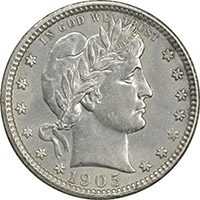Barber Quarters
The Barber quarter replaced the Seated Liberty quarter in 1892, beginning a new era of modern American coinage. Barber’s timeless design features a right-facing Lady Liberty on the obverse and a heraldic eagle on the reverse. Despite a mixed reception when it was first released, this quarter is celebrated today as one of the most iconic American coin designs in history.
Explore L&C Coins’ selection of Barber silver quarters, expand your collection, and discover why this series remains one of the most sought-after in American coin collecting.
History of the Barber Quarter
Origin
By the late 19th century, American tastes in coin design had shifted. The once-celebrated Seated Liberty quarter was now seen as uninspiring and dated. To find a replacement, a competition was hosted in 1891 with a cash prize offered to the winning design. Despite the tempting offer, only a handful of entries were submitted, and none met the standards of Mint Director Edward Leech.
Undeterred, Leech turned to Mint Chief Engraver Charles Barber to bring new life to American coinage. Barber crafted the now-iconic designs for the half dollar, quarter, and dime, launching what would come to be known as the Barber Coin series.
Design
Like other Barber coins, the Barber quarter’s obverse features the Roman-style profile of Lady Liberty facing right. This profile was modeled after local school teacher Anna Willess Williams. She wears a pileus, a crown of laurels, and is surrounded by 13 stars representing the original 13 colonies.
Based on the design of the Great Seal of the United States, the coin’s reverse depicts a heraldic eagle with wings spread and its head pointed to the upper-left of the coin. A shield bearing the stripes of the United States flag is placed over its chest. It clutches an olive branch in its left claw and 13 arrows in its right, representing the American desire for peace and the willingness to use war to defend it. 13 stars and the denomination “United States of America Quarter Dollar” complete the reverse.
Shortly after production began in 1892, it was noted the coin didn’t stack properly. The design was tweaked, creating another version of the 1892 quarter. The original is called Type I while the updated quarter is called Type II. On Type I, the eagle’s wing on the left side covers half of the letter E in “UNITED,” while in Type II, this wing covers the entire letter.
Despite Barber's best efforts, this quarter was met with mixed reactions upon its release. It received a particular scathing critique from renowned sculptor and designer of the beautiful double eagle gold coin, Augustus Saint-Gaudens. “[T]here are a hundred men who could have done very much better than this,” Saint-Gaudens said in an 1891 interview with Harper’s Weekly. “This is inept; this looks it had been designed by a young lady of sixteen, a miss who had taken only a few lessons in modeling. It is beneath criticism, beneath contempt.”
Regardless of how collectors and artists felt about the coin on release, the Barber quarter is now celebrated for being an effective, utilitarian design that withstood decades of wear during circulation.
Circulation and Availability
Widely circulated from 1892 to 1916, the Barber quarter was a common sight in the pockets of American citizens. However, its production only lasted 25 years, the minimum required production time, before it was replaced by the Standing Liberty quarter in 1916.
Despite their relatively brief appearance on the nation's coin stage, the Barber silver quarter has managed to endure and capture the hearts of collectors everywhere. Its simple timeless design, combined with its widespread circulation, makes it a relatively easy coin to collect and add to your collection today. Most of these iconic coins are low-grade, making achieving a set of higher-grade quarters a challenge for collectors.
Some rare key dates include the 1892 Type I, the 1896-S, the 1901-S, and the 1913-S. The 1901-S and 1913-S are notable for their incredibly low mintages. Only 40,000 1901-S and 72,000 1913-S Barber quarters were ever minted.
Find Your Next Treasure With L&C Coins’ Exceptional Selection
Founded in 1974 by Lee Crane, L&C Coins is dedicated to using our expertise to help you enhance your collection. Born from a lifelong love for coins, our family-owned business continues to inspire and nurture a passion for collecting among our customers.
With no-interest layaway plans available, free shipping on all standard orders, and a 15-day return privilege, there’s no reason to wait. Whether you’re a new or seasoned collector, browse our diverse range of authentic coins. If you have any questions, don't hesitate to reach out to our customer support team — we’re here to help!
Frequently-Asked Questions
What are the key dates for Barber quarters?
Some of the key collector’s dates for these quarters include the 1896-S, 1901-S, and the 1913-S. The 1901-S and 1913-S are some of the lowest mintage dates of all 20th century U.S. coins.
What are Barber silver quarters composed of?
Like the Barber dime, this quarter is composed of 90% silver and 10% copper.
How many Barber quarters were minted?
There were 74 different circulation strike issues in the Barber silver quarters series which were minted at Philadelphia, Denver, New Orleans, or San Francisco. In total, 264,670,792 of these coins were minted across all date and mint mark combinations.

